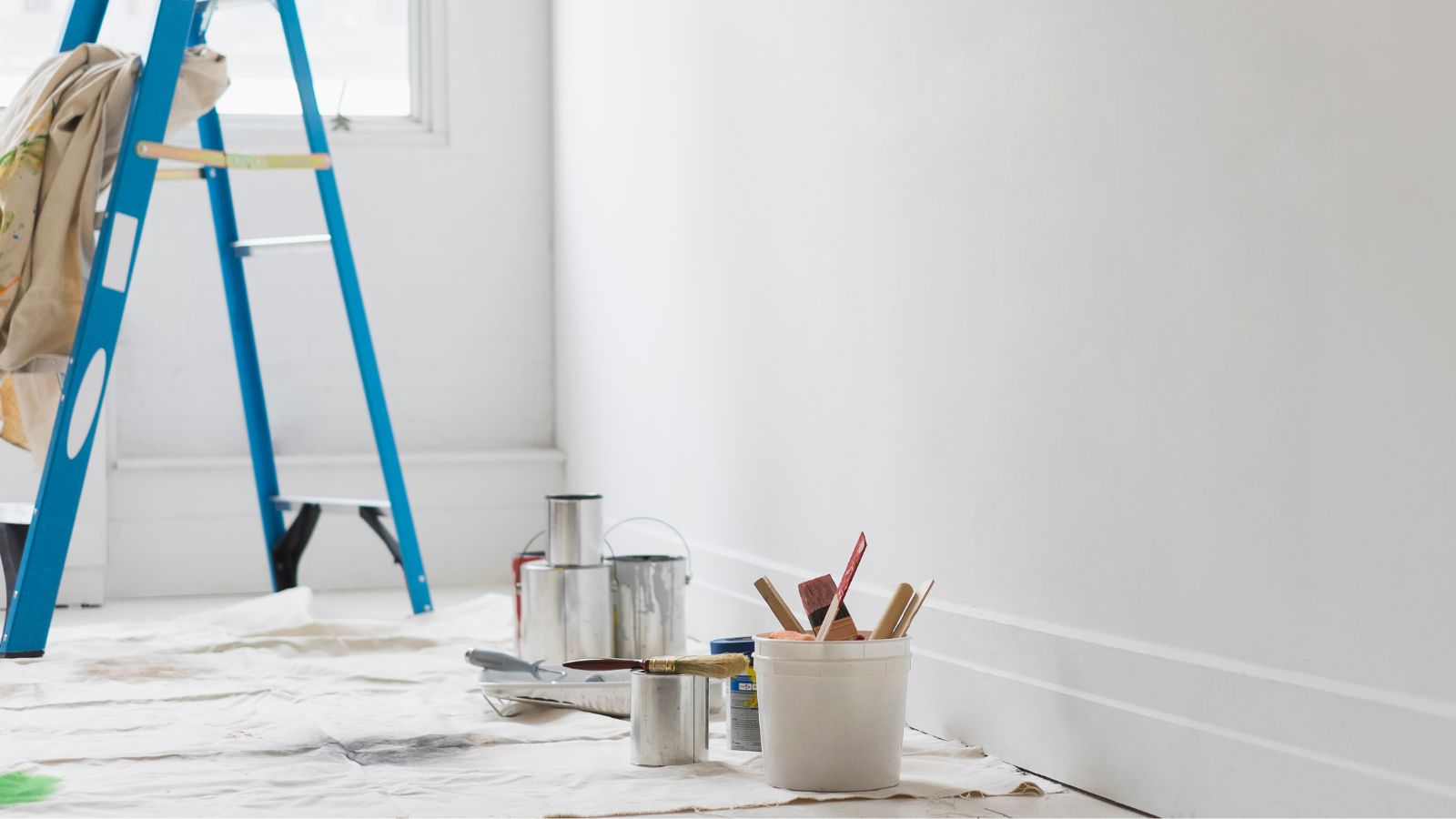Six reasons to use low VOC paints – experts reveal why they're better for you, your home and the environment
Cutting down on chemicals when decorating will reduce physical side effects and be better for the planet


In the not-too-distant past, the main things to take into account when choosing a paint were color and suitability for the surface you wanted to use it on.
But as the desire to use ‘greener’ products around the home has grown, renovators have been looking to low or zero VOC paints to get good coverage that’s better for their health and the environment.
However, VOC-free paints can be considerably more expensive than standard paints, so if your makeover budget is tight, you want to be sure that they are worth the investment and will give you the quality of finish you are looking for. We consulted the experts on why you should go low or no VOC for your next project.
What are VOCs?
Volatile Organic Compounds (VOCs) are found in many household products used for decorating such as paint, stain, glue, and caulk. They can also be found in new furniture, new carpets and wood floors, as well as aerosol sprays, room deodorizers, cleaners and disinfectants.
In a process called off-gassing, they are emitted as pungent fumes that linger in the home and can have an adverse effect on health when breathed in – irritating the eyes, nose and throat, causing headaches and sickness, and even damaging the kidneys, liver and nervous system.
The VOCs can be more highly concentrated indoors than out. In the open, VOCs pollute the air, act as greenhouse gases that contribute to global warming, and can lead to diseases in plants and limited seed production.
Why switch to low VOC paints?
Water and latex-based paints that contained low or zero VOCs started appearing in the mid-90s in the US, with Glidden the first major manufacturer to launch this revolutionary new product.
Other big-name brands such as Benjamin Moore and Sherwin-Williams soon followed. Early versions didn’t perform well as renovators found they lacked the smooth flow and adherence qualities of the high VOC paints. As formulations have advanced, however, issues like ease of application and durability have all improved, closing the quality gaps between VOC paint vs non-VOC paint.
‘In my experience, there is [now] no difference in quality between a low VOC paint versus a traditional paint,’ says Ryan Carrigan, a house-moving expert. ‘In fact, one of the most well-known paint brands in America, Sherwin-Williams, offers every one of their paint colors in a low VOC variety.
‘Unfortunately, large-scale builders and other contractors will often opt for traditional paints because they are cheaper than low VOC paints. If a homeowner plans to hire a contractor for a painting job at their house, they need to specifically request that they use low VOC products.’
Look for certifications such as Green Seal, UL GREENGUARD or UL ECOLOGO to ensure you're choosing a truly low VOC paint that meets strict environmental standards.

As co-founder of moveBuddha, an innovative moving platform based in Athens, Georgia, Ryan helps more than 400,000 people every year to seamlessly relocate, easing the stress of moving to a new home or business.
1. Safer to handle
When it comes to PPE, air respirators (such as the 3M multipurpose respirator available at Lowe's) are necessary for protection against exposure to VOCs, as well as coveralls and goggles, particularly if you are spray painting.
However, you won’t need a mask with low-risk painting tasks applying low VOC paints with a roller or brush. An overall and goggles can prevent irritating splashes in your eyes or on your clothes.
Design expertise in your inbox – from inspiring decorating ideas and beautiful celebrity homes to practical gardening advice and shopping round-ups.
2. Kinder to the environment
'Low VOC paints are a win-win for your health and the environment,’ says Rachel Stringer, a real estate professional. ‘These paints emit up to 80% fewer volatile organic compounds (VOCs) compared to traditional paints. VOCs contribute to smog and can harm air quality, so reducing them is a big deal.
'Plus, many low VOC paints are made with recycled content, which minimizes their environmental footprint. It's a sustainable champion in the world of home decor.’

Working at Raleigh Realty in Cary, NC, Rachel is experienced in interior design and an expert in home staging, renovations, and decor.
3. Better for health
‘As the owner of a paint company, it’s important to us to put the safest products in our team's hands because we have to breathe in it all day every day,’ says Bart Caldwell, owner of Caldwell Painting.
‘In addition to the two true zero VOC interior paints that we use from Benjamin Moore and Sherwin-Williams, we also use mineral-based paints and natural pigments like lime wall paint and Venetian plaster, which enhance air quality by eliminating VOC emissions and absorbing CO2 as they cure.
‘Mineral-based paints are non-toxic, use natural colorants and minerals and are mold and mildew resistant.’

The owner of Tennessee-based Caldwell Painting, Bart has more than 13 years experience in the industry. His firm specialises in transforming the interiors and exteriors of homes.
4. Quick to dry
If you're using high VOC paints, you must make sure the room is well ventilated and to leave it empty until the strong paint smell has evaporated, though the emissions could take up to six months to dissipate.
With low or zero VOC paint, you can move back into the room the same day once it has dried – so there is far less disruption in the home, and you don’t have to find alternative sleeping arrangements to avoid waking up feeling ill from the fresh paint fumes.
5. High performance and no discoloration
‘There is often a misconception that low VOC paints may not be as durable or have the same finish as regular paints,’ says Jonathan Faccone, a real estate developer.
‘With advances in technology, low VOC paints now offer similar if not better quality than regular paints. They also come in various sheens such as matte, eggshell, and semi-gloss to suit different preferences and needs.
‘A benefit of choosing low VOC paints is that they are less likely to cause yellowing over time. Regular paints can often turn yellow due to exposure to sunlight, which can affect the overall appearance of your walls. But with low VOC paints, you can enjoy a longer-lasting and brighter finish without worrying about discoloration.’

Jonathan is a managing member of Halo Homebuyers, a real estate home-buying company based in Bridgewater, NJ, and operating throughout New Jersey and Eastern Pennsylvania.
6. Easier to dispose of
When it comes to getting rid of left over paint, oil-based varieties containing VOCs are considered hazardous waste and should never be poured down the drain or thrown in the trash to end up in landfill. You need to check if they’ll be accepted at the local municipal paint collection program or saved for a hazardous household waste collection day.
The residue of a water-based paint should be allowed to dry and then peeled away and thrown in the trash before the can is recycled. For excess paint, pour over an absorbent material such as sawdust or sand in a paper bag, let it dry and then throw it in the trash.
If you are looking to give your home a refresh, go for the natural look. Read our tips on how to give your rooms an eco style update.

Alison is a contributing gardens writer for Homes & Gardens, writing on a range of topics from plant care to garden design. She has recently landscaped the outside space of her Victorian home, replacing crazy paving and cracked slabs with new lawn, and is currently cultivating a fruit bed.